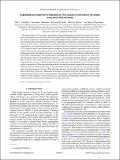Explaining key properties of lithiation in TiO[subscript 2]-anatase Li-ion battery electrodes using phase-field modeling
Author(s)
de Klerk, Niek J. J.; Vasileiadis, Alexandros; Wagemaker, Marnix; Smith, Raymond Barrett; Bazant, Martin Z
DownloadPhysRevMaterials.1.025404.pdf (3.751Mb)
PUBLISHER_POLICY
Publisher Policy
Article is made available in accordance with the publisher's policy and may be subject to US copyright law. Please refer to the publisher's site for terms of use.
Terms of use
Metadata
Show full item recordAbstract
The improvement of Li-ion battery performance requires development of models that capture the essential physics and chemistry in Li-ion battery electrode materials. Phase-field modeling has recently been shown to have this ability, providing new opportunities to gain understanding of these complex systems. In this paper, a novel electrochemical phase-field model is presented that captures the thermodynamic and kinetic properties of lithium insertion in TiO[subscript 2]-anatase, a well-known and intensively studied Li-ion battery electrode material. Using a linear combination of two regular solution models, the two phase transitions during lithiation are described as lithiation of two separate lattices with different physical properties. Previous elaborate experimental work on lithiated anatase TiO[subscript 2] provides all parameters necessary for the phase-field simulations, giving the opportunity to gain fundamental insight in the lithiation of anatase and validate this phase-field model. The phase-field model captures the essential experimentally observed phenomena, rationalizing the impact of C rate, particle size, surface area, and the memory effect on the performance of anatase as a Li-ion battery electrode. Thereby a comprehensive physical picture of the lithiation of anatase TiO[subscript 2] is provided. The results of the simulations demonstrate that the performance of anatase is limited by the formation of the poor Li-ion diffusion in the Li[subscript 1]TiO[subscript 2]
phase at the surface of the particles. Unlike other electrode materials, the kinetic limitations of individual anatase particles limit the performance of full electrodes. Hence, rather than improving the ionic and electronic network in electrodes, improving the performance of anatase TiO[subscript 2] electrodes requires preventing the formation of a blocking Li[subscript 1]TiO[subscript 2]
phase at the surface of particles. Additionally, the qualitative agreement of the phase-field model, containing only parameters from literature, with a broad spectrum of experiments demonstrates the capabilities of phase-field models for understanding Li-ion electrode materials, and its promise for guiding the design of electrodes through a thorough understanding of material properties and their interactions.
Date issued
2017-07Department
Massachusetts Institute of Technology. Department of Chemical Engineering; Massachusetts Institute of Technology. Department of MathematicsJournal
Physical Review Materials
Publisher
American Physical Society (APS)
Citation
de Klerk, Niek J. J., et al. “Explaining Key Properties of Lithiation in TiO 2 -Anatase Li-Ion Battery Electrodes Using Phase-Field Modeling.” Physical Review Materials, vol. 1, no. 2, July 2017. © 2017 American Physical Society
Version: Final published version
ISSN
2475-9953